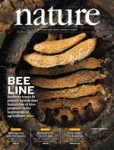You've spilt wax in the kitchen ... again
 There’s an interesting article in yesterday’s Nature on the detection of beeswax residues in crockery shards dating back at least 9000 years i.e. since the development of agriculture. This suggests that humans have been exploiting bees and bee products since the Neolithic Revolution when the first animals were domesticated, though evidence for beekeeping (from wall engravings in Egypt) only exists for about 4500 years. Samples of crockery almost 6000 years old from Southern/Eastern England were found containing traces of wax, but more northerly samples were free from residues. This suggests that there was a northerly/westerly ecological limit to the distribution of honeybees (Apis mellifera) but confirming – assuming Neolithic pastoralists weren’t plagued with imports – that honeybees aren’t a recent introduction to the British Isles.
There’s an interesting article in yesterday’s Nature on the detection of beeswax residues in crockery shards dating back at least 9000 years i.e. since the development of agriculture. This suggests that humans have been exploiting bees and bee products since the Neolithic Revolution when the first animals were domesticated, though evidence for beekeeping (from wall engravings in Egypt) only exists for about 4500 years. Samples of crockery almost 6000 years old from Southern/Eastern England were found containing traces of wax, but more northerly samples were free from residues. This suggests that there was a northerly/westerly ecological limit to the distribution of honeybees (Apis mellifera) but confirming – assuming Neolithic pastoralists weren’t plagued with imports – that honeybees aren’t a recent introduction to the British Isles.
Join the discussion ...